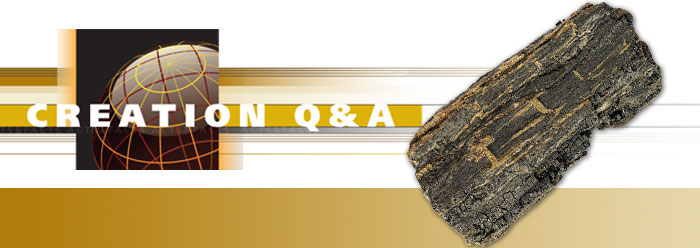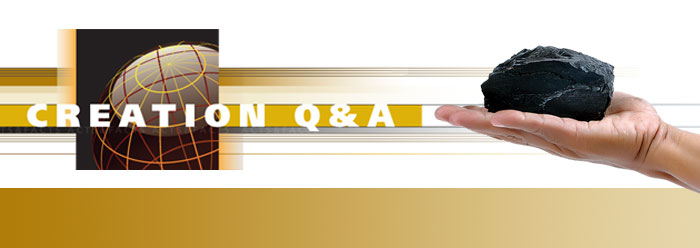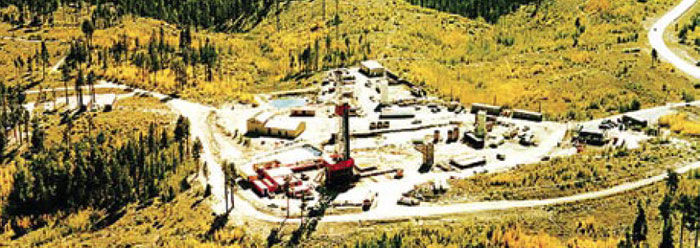You've got two decay products, lead and helium, and they're giving two different ages for the zircon.
Radiometric Dating
For many people, radiometric dating might be the one scientific technique that most blatantly seems to challenge the Bible’s record of recent creation. For this reason, ICR research has long focused on the science behind these dating techniques.
Along with scores of other Bible-believing geologists, ICR scientists have made key observations that compel us to reject the millions-of-years apparent ages that these techniques yield:
- First, rocks of known age always show vastly inflated radioisotope “ages.”
- Second, various radioisotope methods or even various attempts using the same method yield discordant ages more often than concordant ages.
- Third, many dating methods that don't involve radioisotopes—such as helium diffusion, erosion, magnetic field decay, and original tissue fossils—conflict with radioisotope ages by showing much younger apparent ages.
These observations give us confidence that radiometric dating is not trustworthy. Research has even identified precisely where radioisotope dating went wrong. See the articles below for more information on the pitfalls of these dating methods.
Resources › Physical Sciences Resources» Up One Level
Related Articles
However, there is also independent evidence within these Norwegian eclogites of these flows of hot fluids that were responsible for the rapid metamorphism of the precursor granulites. A sample of related eclogite containing biotite flakes was closely examined and polonium-210 radiohalos were found in it (7 polonium-210 radiohalos in 50 microscope slides, each containing 20-30 biotite flakes).21 This discovery, the first time any radiohalos have been documented in eclogites, is highly significant.Biotite was not in the precursor granulites, so it had to form as a result of both their metamorphism to eclogite and the fluid flows. Of course, these radiohalos could only have been produced in the biotite grains after they formed. Furthermore, because there was no source of either parent uranium-238 or its radioactive decay products within either the eclogites or the precursor granulites, the large quantities of polonium-210 required to generate these radiohalos had to have been transported from external sources into the biotite flakes within these rocks by the hot fluids.22 But the polonium-210 only has a half-life of 138 days, and the radiohalos would only have formed and survived after the temperature in the rocks fell below 150°C. So this drastically restricts the duration of the earthquake-triggered hot fluid flows and associated eclogite metamorphism even more, perhaps to only a few weeks or months! And because the heat flow into the granulites to metamorphose them would have been primarily by convection associated with the fluid flows, rather than just by conduction,23 such a drastically short timescale of only weeks for this eclogite metamorphism is entirely feasible.
Conclusion
Of course, in conventional geological dogma which primarily envisages slow and gradual processes over long ages, even a timescale of ten years is almost too radical and controversial to be readily accepted. However, in the context of accelerated catastrophic erosion, deposition of thick strata sequences, earth movements, plate tectonics and continental collisions during the year-long global Genesis Flood, it is entirely feasible that rapid flows of hot fluids triggered by earthquakes were injected into shear zones within the granulites to transform them into eclogites within weeks. Once again, continued research has provided evidence that confirms the feasibility of another aspect of the Creation-Flood model of Earth history, namely, rapid metamorphism of rocks during the Genesis Flood, consistent with the infallible record of God's Word.
References
- Bucher, K., and M. Frey, 2002. Petrogenesis of Metamorphic Rocks, 7th edition, pp. 67-68, Springer-Verlag, Berlin.
- Snelling, A. A., 1994. "Towards a Creationist Explanation of Regional Metamorphism." Creation Ex Nihilo Technical Journal, 8(1):51-77.
- Snelling, A. A., 1994. "Regional Metamorphism Within a Creationist Framework: What Garnet Compositions Reveal." In Proceedings of the Third International Conference on Creationism, R. E. Walsh (editor), pp. 485-496. Creation Science Fellowship, Pittsburgh, PA.
- Kelley, S., 2005. "Hot Fluids and Cold Crusts." Nature, 435:1171.
- Wain, A. L., D. J. Waters, and H. Austrheim, 2001. "Metastability of Granulites and Processes of Eclogitisation in the UHP Region of Western Norway." Journal of Metamorphic Geology, 19:607-623.
- Austrheim, H., and W. L. Griffin, 1985. "Shear Deformation and Eclogite Formation within Granulite Facies Anorthosites of the Bergen Arcs, Western Norway." Chemical Geology, 50:267-281.
- Boundy, T. M., and D. M. Fountain, 1992. "Structural Development and Petro-fabrics of Eclogite Facies Shear Zones, Bergen Arcs, Western Norway: Implications for Deep Crustal Deformational Processes." Journal of Metamorphic Geology, 10:127-146.
- Austrheim, H., M. Erambert, and T. M. Boundy, 1996. "Garnets Record Deep Crustal Earthquakes." Earth and Planetary Science Letters, 139:223-238.
- Austrheim, H., and T. M. Boundy, 1994. "Pseudotachylytes Generated During Seismic Faulting and Eclogitization of the Deep Crust." Science, 265:82-83.
- Kühn, A., J. Glodny, K. Iden, and H. Austrheim, 2000. "Retention of Precambrian Rb/Sr Phlogopite Ages through Caledonian Eclogite Facies Metamorphism, Bergen Arc Complex, W-Norway." Lithos, 51:305-330.
- Bingen, B., W. J. Davis, and H. Austrheim, 2001. "Zircon U-Pb Geochronology in the Bergen Arc Eclogites and Their Proterozoic Protoliths, and Implications for the Pre-Scandian Evolution of the Caledonides in Western Norway." Geological Society of America Bulletin, 113(5):640-649.
- Jamtveit, B., K. Bucher-Nurminen, and H. Austrheim, 1990. "Fluid Controlled Eclogitization of Eclogites in Deep Crustal Shear Zones, Bergen Arcs, Western Norway." Contributions to Mineralogy and Petrology, 104:184-193.
- Austrheim, H., and T. M. Boundy (1994), op. cit.
- Camacho, A., J. K. W. Lee, B. J. Hensen, and J. Braun, 2005. "Short-lived Orogenic Cycles and the Eclogitization of Cold Crust by Spasmodic Hot Fluids." Nature, 435:1191-1196.
- Kelley, S. (2005), op. cit.
- Camacho, A., J. K. W. Lee, B. J. Hensen, and J. Braun (2005), op. cit.
- Jamtveit, B., H. Austrheim, and A. Malthe-Sorenssen, 2000. "Accelerated Hydration of the Earth's Deep Crust Induced by Stress Perturbations." Nature, 408:75-78.
- Austrheim, H., and T. M. Boundy (1994), op. cit.
- Bjornerud, M., H. Austrheim, and M. G. Lund, 2002. "Processes Leading to Eclogitization (Densification) of Subducted and Tectonically Buried Crust." Journal of Geophysical Research, 107(B10):2252-2269.
- VanHaren, J. L. M., J. J. Ague, and D. M. Rye, 1996. "Oxygen Isotope Record of Fluid Infiltration and Mass Transfer During Regional Metamorphism of Pelitic Schist, Connecticut, USA." Geochimica et Cosmochimica Acta, 60(18):3487-3504.
- Snelling, A. A., 2005. "Radiohalos in Granites: Evidence for Accelerated Nuclear Decay." In Radioisotopes and the Age of the Earth: Results of a Young-Earth Creationist Research Initiative, L. Vardiman, A. A. Snelling, and E. F. Chaffin (editors), chapter 3, pp. 101-207 (especially Table 4, p. 188). Institute for Creation Research, El Cajon, CA, and Creation Research Society, Chino Valley, AZ.
- Snelling, A. A. (2005), op. cit.
- Snelling, A. A., and J. Woodmorappe, 1998. "The Cooling of Thick Igneous Bodies on a Young Earth." In Proceedings of the Fourth International Conference on Creationism, R. E. Walsh (editor), pp. 527-545. Creation Science Fellowship, Pittsburgh, PA.
* Dr. Snelling is an associate professor in the Geology Department at ICR.
[body_edit] =>Where thick sequences of sedimentary rock layers have been deposited in large basins, the deepest layers at the bottoms of the sequences may subsequently have become folded by earth movements when subjected to elevated temperatures and pressures that were sufficient to transform them into metamorphic rocks. Thus the clay particles in shales and the mineral grains in sandstones were metamorphosed into the new minerals found today in schists and gneisses. Geologists conventionally envisage these metamorphic processes as having required millions of years.1
In contrast, creation geologists maintain that just as thick sequences of sedimentary rocks were rapidly deposited and movements of the tectonic plates of the earth's crust occurred rapidly during the year-long Flood catastrophe, these associated metamorphic processes were likewise rapid. The hot waters that saturated the deeply buried sedimentary and other rocks, and/or that flowed rapidly through them, were responsible for the rapid mineral transformations.2,3
Norwegian Metamorphic Rocks
Conventional geologists were surprised recently by documented evidence for rapid metamorphism.4 Along the southwest coast of Norway, in the Bergen area, former igneous (intrusive) rocks were radically transformed into high-grade metamorphic rocks known as granulites by the high pressures exerted on them deep in the earth's crust late in the Precambrian.5 During a subsequent continental collision in the Silurian, hot fluids penetrated along closely-spaced shear zones, where rocks are believed to have deformed plastically as they moved sideways against each other, and transformed most of the granulites into another metamorphic rock called eclogite.6
These eclogites are strikingly beautiful, coarse-grained, and characterized by large pink garnets in a green matrix, rich in pyroxene. They are conventionally believed to have formed at depths of some 60 km and temperatures of around 700°C.7 However, these Norwegian eclogites paradoxically exhibit features more commonly associated with tectonic processes at lower temperatures closer to the earth's surface.8,9 Furthermore, rubidium-strontium radioisotope dating of the granulite lenses immediately adjacent to these eclogites yields an "age" closer to that of the untransformed granulite,10,11 even though the temperatures supposedly required for formation of the eclogites should have obliterated that earlier "age."12 Thus it has been suggested that the Norwegian granulite-eclogite transformation must have occurred during short-lived fluid flow events over less than a million years.13
A Radical Short Timescale
However, a drastically shorter timescale has now been proposed,14 one that "will make many geologists draw breath!"15 An ultraviolet laser was used to measure profiles of argon-argon radioisotope "ages" across individual mineral grains in the untransformed granulite lenses.16 In this technique the abundance of argon-40 (which forms from the radioactive decay of potassium-40) supposedly indicates the elapsed time since the temperature was last high enough for the argon (a gas) to diffuse rapidly through these minerals and escape at the boundaries between grains. The "ages" thus obtained not only confirmed the earlier rubidium-strontium "dates," but demonstrated just how little the granulite lenses had been affected by the later formation of the immediately adjacent eclogites.
Furthermore, these argon-40 data were then used to estimate what the temperature must have been in the granulite lenses during formation of the eclogites. The estimate—less than 400°C—is dramatically lower than the conventional requirement of around 700°C for formation of the immediately adjacent eclogites. The only way this glaring inconsistency can be reconciled is if the time period over which the heat was applied to these granulites during their adjacent metamorphism to eclogites was drastically shorter than the previously suggested one million years or less. It was calculated that the total heating duration must have been around only 18,000 years to explain the argon-argon "age" profiles in the mineral grains.
However, even more radical is the conclusion from heat-conduction calculations that the individual fluid flow "events," when hot fluids (at 700°C) flowed through the shear zones in the granulites and metamorphosed them to eclogites, had to have lasted just ten years or less, otherwise there would have been significant heating beyond 400°C of the surviving granulite lenses between the shear zones. Furthermore, it was concluded that this is exactly what would be expected if fluid migration was triggered by multiple, spasmodic deformation events associated with earthquakes, in which the hot fluids were repeatedly injected into, and pumped along, the shear zones by earth movements. This is consistent with the evidence of hydraulic fracturing17 and rocks formed by friction melting along fractures18 associated with these eclogite-bearing shear zones.19 Thus this model overturns conventional long-age thinking by evoking a radically different picture for the conditions responsible for eclogite metamorphism, in which the exceedingly rapid metamorphic transformation occurs in only ten years or less!
Confirming Evidence
Such rapid fluid flow events are not without precedent, having been associated with vein formation during regional metamorphism of schists in Connecticut (USA).20
However, there is also independent evidence within these Norwegian eclogites of these flows of hot fluids that were responsible for the rapid metamorphism of the precursor granulites. A sample of related eclogite containing biotite flakes was closely examined and polonium-210 radiohalos were found in it (7 polonium-210 radiohalos in 50 microscope slides, each containing 20-30 biotite flakes).21 This discovery, the first time any radiohalos have been documented in eclogites, is highly significant.
Biotite was not in the precursor granulites, so it had to form as a result of both their metamorphism to eclogite and the fluid flows. Of course, these radiohalos could only have been produced in the biotite grains after they formed. Furthermore, because there was no source of either parent uranium-238 or its radioactive decay products within either the eclogites or the precursor granulites, the large quantities of polonium-210 required to generate these radiohalos had to have been transported from external sources into the biotite flakes within these rocks by the hot fluids.22 But the polonium-210 only has a half-life of 138 days, and the radiohalos would only have formed and survived after the temperature in the rocks fell below 150°C. So this drastically restricts the duration of the earthquake-triggered hot fluid flows and associated eclogite metamorphism even more, perhaps to only a few weeks or months! And because the heat flow into the granulites to metamorphose them would have been primarily by convection associated with the fluid flows, rather than just by conduction,23 such a drastically short timescale of only weeks for this eclogite metamorphism is entirely feasible.
Conclusion
Of course, in conventional geological dogma which primarily envisages slow and gradual processes over long ages, even a timescale of ten years is almost too radical and controversial to be readily accepted. However, in the context of accelerated catastrophic erosion, deposition of thick strata sequences, earth movements, plate tectonics and continental collisions during the year-long global Genesis Flood, it is entirely feasible that rapid flows of hot fluids triggered by earthquakes were injected into shear zones within the granulites to transform them into eclogites within weeks. Once again, continued research has provided evidence that confirms the feasibility of another aspect of the Creation-Flood model of Earth history, namely, rapid metamorphism of rocks during the Genesis Flood, consistent with the infallible record of God's Word.
References
- Bucher, K., and M. Frey, 2002. Petrogenesis of Metamorphic Rocks, 7th edition, pp. 67-68, Springer-Verlag, Berlin.
- Snelling, A. A., 1994. "Towards a Creationist Explanation of Regional Metamorphism." Creation Ex Nihilo Technical Journal, 8(1):51-77.
- Snelling, A. A., 1994. "Regional Metamorphism Within a Creationist Framework: What Garnet Compositions Reveal." In Proceedings of the Third International Conference on Creationism, R. E. Walsh (editor), pp. 485-496. Creation Science Fellowship, Pittsburgh, PA.
- Kelley, S., 2005. "Hot Fluids and Cold Crusts." Nature, 435:1171.
- Wain, A. L., D. J. Waters, and H. Austrheim, 2001. "Metastability of Granulites and Processes of Eclogitisation in the UHP Region of Western Norway." Journal of Metamorphic Geology, 19:607-623.
- Austrheim, H., and W. L. Griffin, 1985. "Shear Deformation and Eclogite Formation within Granulite Facies Anorthosites of the Bergen Arcs, Western Norway." Chemical Geology, 50:267-281.
- Boundy, T. M., and D. M. Fountain, 1992. "Structural Development and Petro-fabrics of Eclogite Facies Shear Zones, Bergen Arcs, Western Norway: Implications for Deep Crustal Deformational Processes." Journal of Metamorphic Geology, 10:127-146.
- Austrheim, H., M. Erambert, and T. M. Boundy, 1996. "Garnets Record Deep Crustal Earthquakes." Earth and Planetary Science Letters, 139:223-238.
- Austrheim, H., and T. M. Boundy, 1994. "Pseudotachylytes Generated During Seismic Faulting and Eclogitization of the Deep Crust." Science, 265:82-83.
- Kühn, A., J. Glodny, K. Iden, and H. Austrheim, 2000. "Retention of Precambrian Rb/Sr Phlogopite Ages through Caledonian Eclogite Facies Metamorphism, Bergen Arc Complex, W-Norway." Lithos, 51:305-330.
- Bingen, B., W. J. Davis, and H. Austrheim, 2001. "Zircon U-Pb Geochronology in the Bergen Arc Eclogites and Their Proterozoic Protoliths, and Implications for the Pre-Scandian Evolution of the Caledonides in Western Norway." Geological Society of America Bulletin, 113(5):640-649.
- Jamtveit, B., K. Bucher-Nurminen, and H. Austrheim, 1990. "Fluid Controlled Eclogitization of Eclogites in Deep Crustal Shear Zones, Bergen Arcs, Western Norway." Contributions to Mineralogy and Petrology, 104:184-193.
- Austrheim, H., and T. M. Boundy (1994), op. cit.
- Camacho, A., J. K. W. Lee, B. J. Hensen, and J. Braun, 2005. "Short-lived Orogenic Cycles and the Eclogitization of Cold Crust by Spasmodic Hot Fluids." Nature, 435:1191-1196.
- Kelley, S. (2005), op. cit.
- Camacho, A., J. K. W. Lee, B. J. Hensen, and J. Braun (2005), op. cit.
- Jamtveit, B., H. Austrheim, and A. Malthe-Sorenssen, 2000. "Accelerated Hydration of the Earth's Deep Crust Induced by Stress Perturbations." Nature, 408:75-78.
- Austrheim, H., and T. M. Boundy (1994), op. cit.
- Bjornerud, M., H. Austrheim, and M. G. Lund, 2002. "Processes Leading to Eclogitization (Densification) of Subducted and Tectonically Buried Crust." Journal of Geophysical Research, 107(B10):2252-2269.
- VanHaren, J. L. M., J. J. Ague, and D. M. Rye, 1996. "Oxygen Isotope Record of Fluid Infiltration and Mass Transfer During Regional Metamorphism of Pelitic Schist, Connecticut, USA." Geochimica et Cosmochimica Acta, 60(18):3487-3504.
- Snelling, A. A., 2005. "Radiohalos in Granites: Evidence for Accelerated Nuclear Decay." In Radioisotopes and the Age of the Earth: Results of a Young-Earth Creationist Research Initiative, L. Vardiman, A. A. Snelling, and E. F. Chaffin (editors), chapter 3, pp. 101-207 (especially Table 4, p. 188). Institute for Creation Research, El Cajon, CA, and Creation Research Society, Chino Valley, AZ.
- Snelling, A. A. (2005), op. cit.
- Snelling, A. A., and J. Woodmorappe, 1998. "The Cooling of Thick Igneous Bodies on a Young Earth." In Proceedings of the Fourth International Conference on Creationism, R. E. Walsh (editor), pp. 527-545. Creation Science Fellowship, Pittsburgh, PA.
* Dr. Snelling is an associate professor in the Geology Department at ICR.
[typeID] => 2 [visible] => t [pdf] => /i/pdf/imp/imp-392.pdf [publishURL] => confirmation-rapid-metamorphism-rocks [publishDate] => 0000-00-00 [authorAsterisk] => t [domainID] => 1 [publication] => [volume] => [issue] => [page] => [author] => Andrew A. Snelling, Ph.D. ) -->












